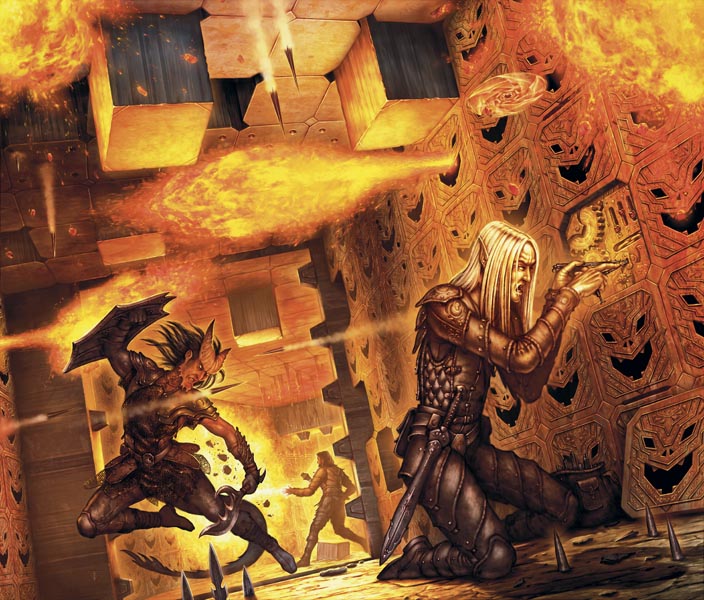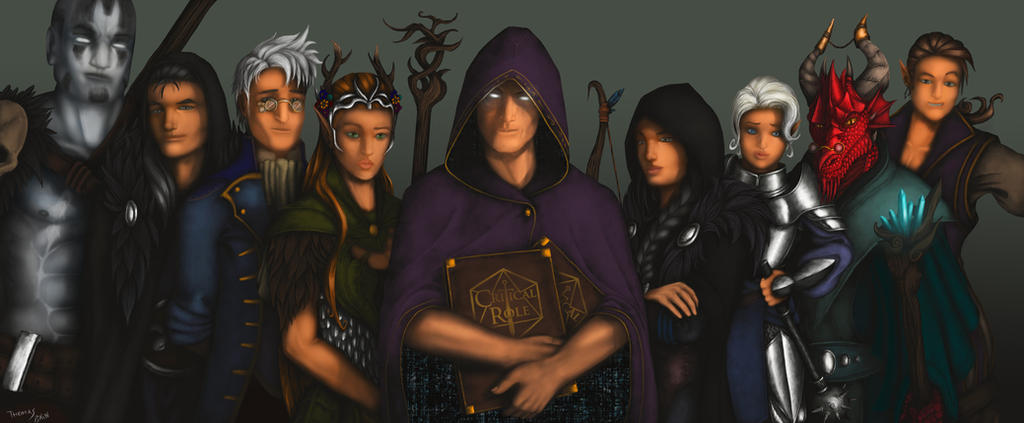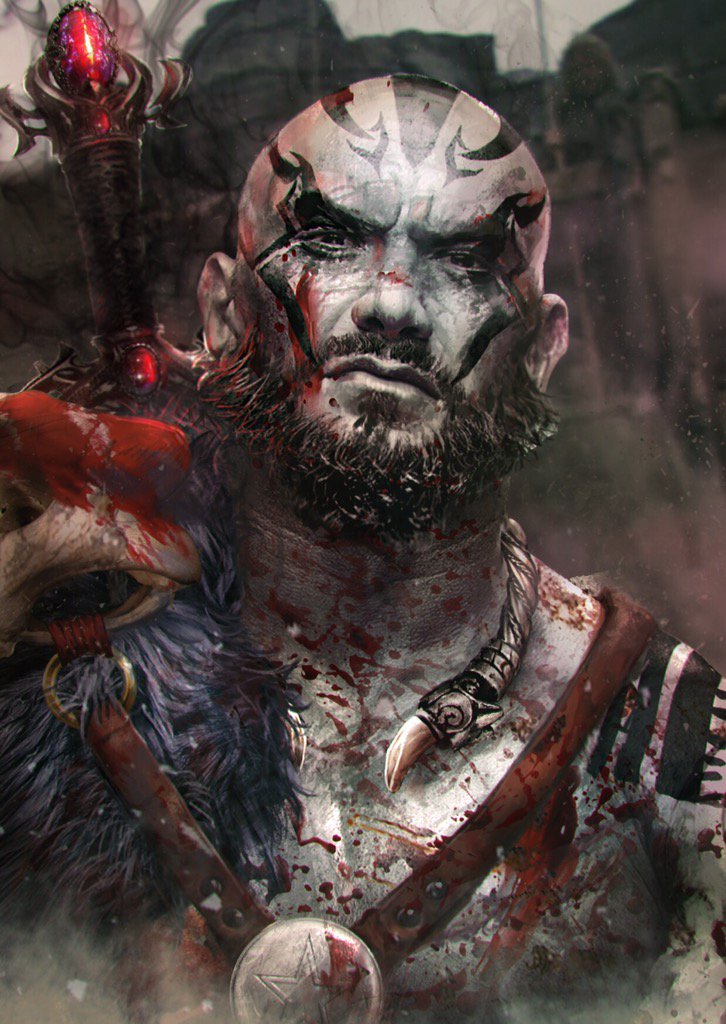 |
| Source |
Turn 1: "I search for a control panel" *rolls a nat 20, clearly*... DM: "Wow. Okay. You find one in the wall behind one of the face plates."
Turn 2: "I disable the device" *rolls something we don't know yet based on the picture*
There is no drama here! The only thing that is going on here is dozens and dozens of dice rolls until enough high or low rolls are made, and then the DM either tells the players "You shut of the trap/escape" or "You die".
It's almost laughable how much this picture overcompensates for the lack of tangible drama the D&D trap mechanics actually cause. Look at all the bull$hit going on in that picture! I don't care what system you are running, that situation is unplayable.
So if that is how you do traps wrong, how do you do them right?
Traps are not a game of dice. Traps are a game of information. Adventurers survive when they have enough information, and then process that information correctly. For my money, information should never be rolled for, it should be role-played for. What information do the players get? Well, that depends on what kind of trap we're talking about.
Big Trap?
or...
Small Trap?
A big trap involves a major change in circumstances: falling into a deep pit, being run-down by a huge boulder, getting caught in a room that is filling with water, etc. Interacting with these traps and their aftermath could last as long as a combat encounter.
A small trap generally involves deterring a character from interacting with something: an explosive runes spellbook trap, a flame-jet trapped treasure chest, a poison covered doorknob, etc. These traps are short and sweet, and should be avoidable in mere minutes, if the party has the resources to do so. A poison doorknob can be avoided with a spare rag. A trapped spellbook may require traveling back to the city to get the assistance of a high-level magic-user.
Now, let's get something out of the way right here: there is no real reason why traps should be detectable. Just like there is no real reason why that level 1 dungeon shouldn't have twelve cave trolls in it, instead of one.
But this wonderful hobby of ours is about letting players risk their characters for highly rewarding (and uncertain) outcomes. If a situation clearly spells doom for the party, then it shouldn't be sprung on your players. Sure, they could always goad the ancient dragon, and then all get eaten as their just desserts. But at least they knew what they were getting into. Opening a door and being thrust into an encounter that is impossible to win, or a deadly trap that is impossible to avoid, isn't fun or engaging for the players, it's pointless.
So when it comes to traps, sure, you could make it undetectable except on a DC 48 search check, regardless of whether someone says "I scan the chest for signs of traps." But if you did, you'd be a dick.
Really no two ways around it.
You need to make sure that every trap you put into your game has at least a few warning signs that become apparent upon a players saying "I check the [insert whatever here] for traps/anything weird," or even just saying they do something that would get them close enough to notice.
Example: the flame-jet trap on a treasure chest.
This trap could be mechanical, or magical. If it was mechanically constructed, you could say that there is a VERY thin, almost invisible wire that runs from the latch at the front, across the top of the chest, and into the space at the back next to the hinges. Upon a player saying they inspect the chest, you tell them about the wire, and how it is under a lot of tension.
If it's magical, perhaps there is a rune inscribed on the side of the chest so that half of it is on the upper part of the chest, and half is on the lower part. It makes one symbol when the chest is closed, but opening it will split the symbol in two.
And that's it.
You don't say "This looks like a flame-jet trap." You don't say "Something is probably going to shoot out of the chest when it's opened." You just describe the warning signs. Then, the party needs to figure out what they are going to do. Cut the wire? Open the chest with the fighter's greatsword? Cast antimagic field and then open it normally? Pick the chest up and throw it across the room? Bring the closed chest back to town and figure it out later?
And the best part is that all of this can be role-played. There is no roll that will make or break your party's strategy or chances of survival.
Another example: a room that locks itself and fills with water upon a character turning a knob attached to a false door in the wall.
What are the warning signs here? Well, the water has to come in somehow. Sure, they could be totally hidden before the knob is turned, but what fun is that? Have some metal slits at the top of the walls that circle the whole room. Have them be slightly wet upon inspection. And the water has to drain somehow after the trap is sprung, otherwise this is a one-use room. The drains would need to seal off, but you could have some puddles on the floor. Where did those come from, I wonder?
And that false door should obviously be false upon inspection, but that's it. They get nothing else from looking at it. If the rogue says "I check the door for traps," I reply "The door appears to be fake. You suspect there is just more wall behind it," done. There is no way that by simply inspecting the knob a person could deduce the water trap. But once they know the door is fake, but the knob seems real, and if they think about the puddles and the damp wall slits, then a picture starts to come together.
Once water starts filling the room and the doors magically seal, the players focus should now be on how the trap shuts off. Plugging the slits in the walls is probably not going to work, unless the wizard has some powerful spell they are willing to spend.
Maybe there is a small sapphire on the ceiling that hangs down a few inches, and when the water touches the sapphire, the traps shuts off and drains opens up in the floor? Now, a player frantically looking over the room as it floods can put two-and-two together and try to splash water onto the gem to preemptively shut the water off.
And if they don't figure that out, someone needs to think of a way to trap some air inside the room to breath for a bit after it fills up. Again, the water has to drain at some point, hence only puddles being left when they walked in.
Be sure to preset the rate at which the water fills the room, so that there really is an objective time-limit to the PC's attempts. That keeps you, the DM, honest, and allows you to answer accurately when the party asks how deep the water is each round.
So to quickly summarize:
1. WARNING SIGNS WARNING SIGNS WARNING SIGNS!! One at least, more for more dangerous and intensive traps.
2. Give out the warning signs freely. If they waltz right by, then they miss it and get the short end of the stick. But if they tread carefully, the information should fall in their laps.
3. Role-play it. Anyone can try to plug a hole, or smash a chest, or cut a wire so long as they have the tools to do so.






